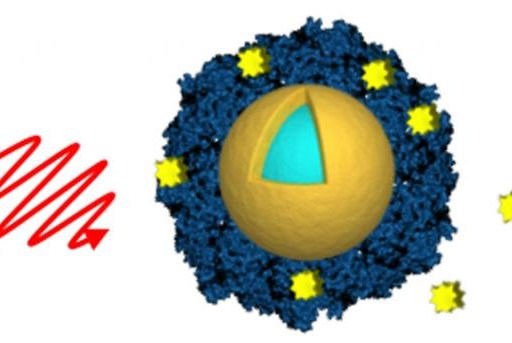When hit with a laser pulse, the nanoshells release cancer drugs inside the targeted tumor cell. Photo by A. Goodman/Rice University
Nov. 9 (UPI) -- Scientists at Rice University are perfecting a novel drug delivery system for treating cancer. The system utilizes gold nanoparticles, which, when zapped with a laser, release a drug inside the tumor cells.
In recent lab tests, scientists used gold nanoparticles to smuggle toxic doses of two common cancer drugs, lapatinib and docetaxel, into breast cancer cells. When hit with the laser, the nanoshells successfully released the drug doses.
Drugs used to treat cancer are especially toxic and are often rejected by tumor cells. To have an effect on the hard-to-penetrate cells, large doses are required. These large doses cause a variety of harmful, often intolerable side effects.
By sneaking small doses into cancer cells, scientists can more accurately target tumors while avoiding the side effects that sicken patients.
The latest tests results -- detailed in the journal PNAS -- prove their delivery technology is sound and that the nanoshsells don't release the drugs before being triggered.
The nanoparticles -- made of glass, coated in gold and tuned to respond to specific laser wavelengths -- are smuggled into the cancer cells using the Trojan-horse strategy.
"In future studies, we plan to use a Trojan-horse strategy to get the drug-laden nanoshells inside tumors," Naomi Halas, an engineer, chemist and physicist at Rice, said in a news release. "Macrophages, a type of white blood cell that's been shown to penetrate tumors, will carry the drug-particle complexes into tumors, and once there we use a laser to release the drugs."
Halas first developed nanoshsells more than 15 years ago and has been slowly improving the technology ever since. In the latest study, she and her colleagues wanted to test the delivery system using two new types of lasers signals.
The researchers successfully triggered the drug release using both continuous-wave laser triggering and low-power pulse laser triggering.
Halas and her colleagues hope the latest results will translate to other types of cancer drugs.
"I'm particularly excited about the potential for lapatinib," said Susan Clare, a research associate professor of surgery at the Northwestern University Feinberg School of Medicine. "The first time I heard about Naomi's work, I wondered if it might be the answer to delivering drugs into the anoxic -- depleted of oxygen -- interior of tumors where some of the most aggressive cancer cells lurk. As clinicians, we're always looking for ways to keep cancer from coming back months or years later, and I am hopeful this can do that."
While the most recent tests only featured cancer cells in culture dishes, they expect their next study to test the delivery system on animal models.
Scientists at other institutions are working on similar technologies. In a recent study, researchers experimented with drug-carrying polymer nanoparticles capable of changing shape in order to accommodate different types of drugs and target specific cells.















